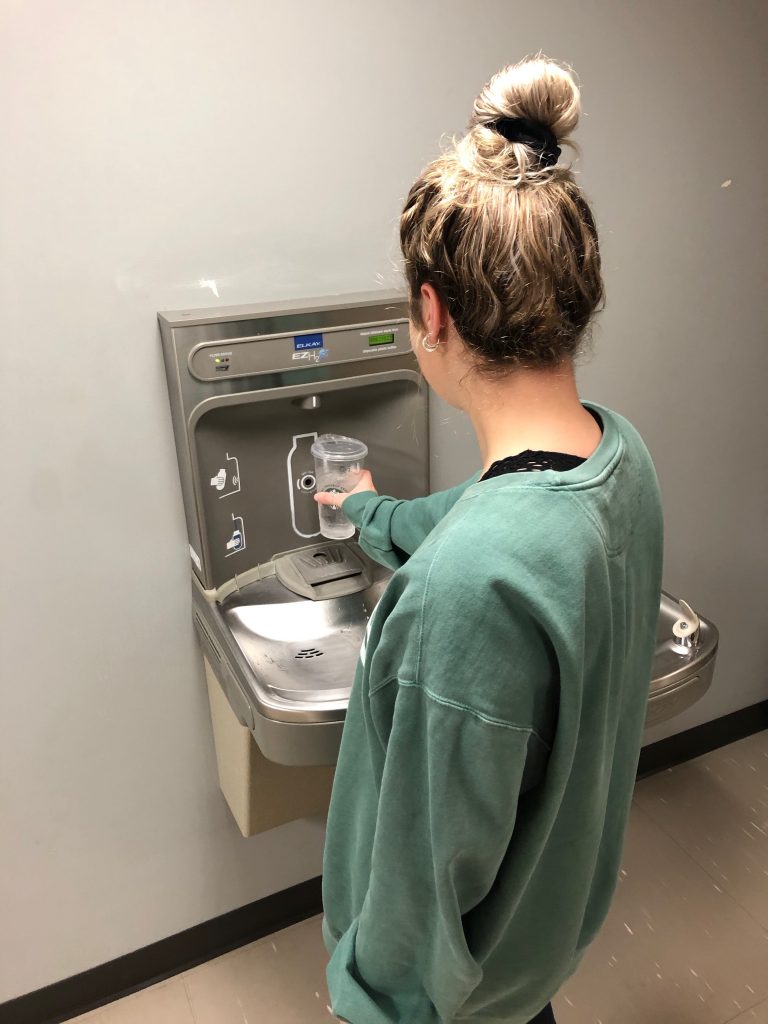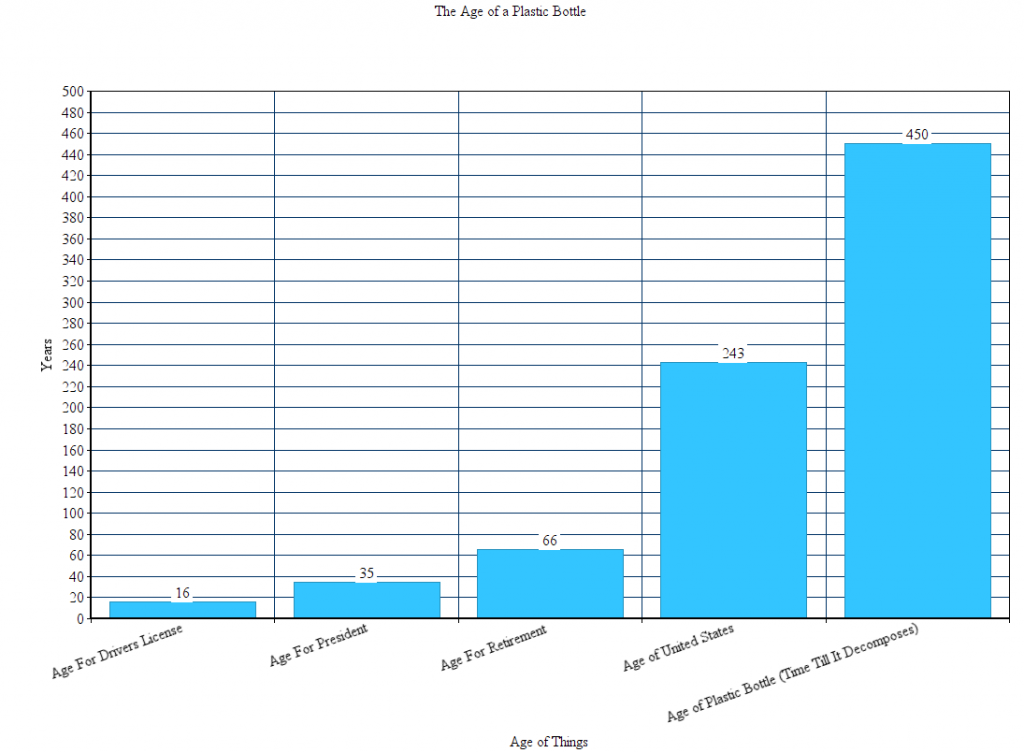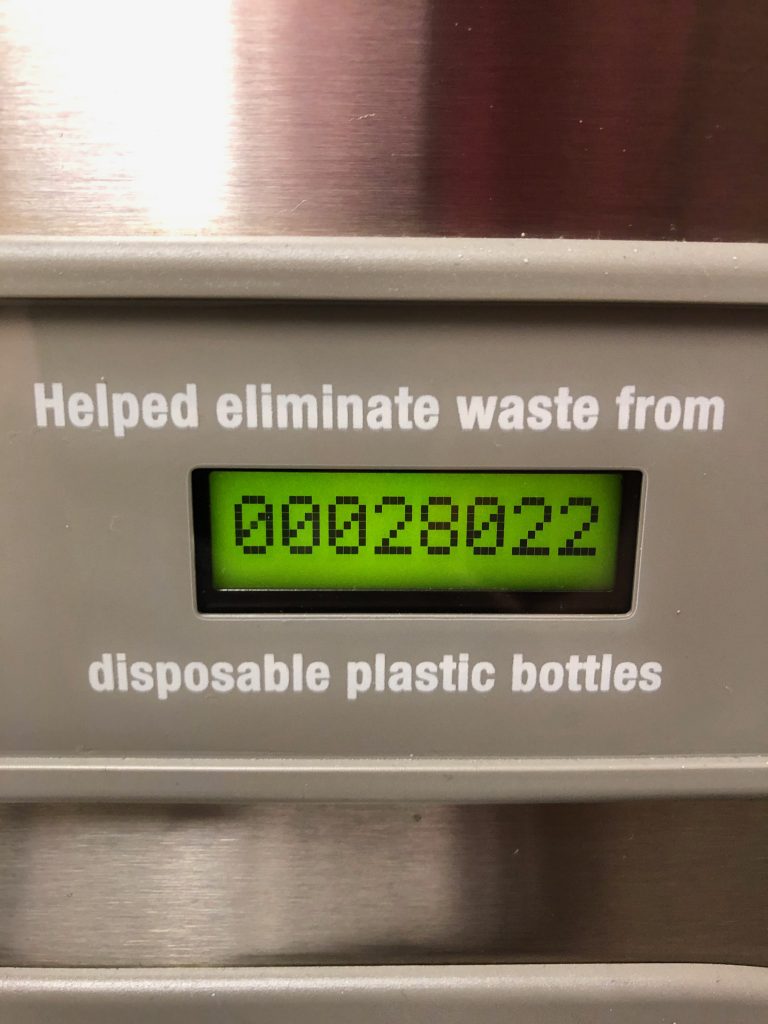Water bottle refill stations have been placed across Millersville’s campus to promote sustainability and combat single-use plastic waste. By Brian Treible
What are Water Bottle Refill Stations? As sustainability has become a focal point of Millersville University’s Identity, the promotion of reusable water bottles have shifted to an aspect of that initiative. Since the renovation of the Student Memorial Center in 2012 and the Mcnairy Library and Learning Forum in 2013, many reusable water bottle refilling stations have been added to water fountains across Millersville University’s campus and other facilities.
The refiling stations look just like regular water fountains but have canopies with spouts attached. These canopies have sensors that control the release of the water which allows patrons to place their water bottle under the spout and fill it hands-free. Each station shows the number of times it “helped eliminate waste from ___ disposable plastic bottles”, which indicates these machines are for more than just keeping students and faculty hydrated.
These stations can replace hundreds of thousands of plastic water bottles in the life span of one of their filters, which is measured by a green, yellow and red light indicator that represents the integrity of the filter. Although these machines do have filters, one shouldn’t worry about the integrity of the filters because Millersville taps all of its water fountains from a naturally filtered underground aquifer.
What’s The Purpose? Earthday.org shares that the entire plant buys around 1,000,000 plastic bottles every minute in total and less than 25% of plastic bottles are recycled within the U.S. The United States is actually the number 1 country when it comes to the consumption of single-use plastic bottles. With the ones that don’t make it to the recycling bin, which nearly 91% is not recycled, single-use plastic bottles build up in our landfills, become littered in our oceans, forests and across the ground. Plastic bottles can take up to 450 years to decompose, which is nearly 207 years longer than the United States has been a country. These water refilling stations can combat the use of these plastic bottles around campus and reduce the amount of plastic bottle waste the campus produces. Reusing water bottles and using these stations doesn’t just promote sustainability and save the environment, it saves students and faulty money too. Water from a purchased in a pre-packaged plastic bottle cost around 4000 times more per gallon than water from the tap. If the average water bottle cost around one dollar, these water refill stations can save Millersville Students and faculty upwards of $100,000.
Photo By Brian Treible
Future of Sustainability Although the Millersville University is promoting the reusable water bottles, this initiative only works if the students and faculty partake. With the estimate that more than half a trillion plastic bottles will be purchased by the end of this year, it may be time for us as consumers to take matters into our own hands, choose not to purchase these one-use plastics and use opportunities like the water refill stations to combat the build-up of this plastic bottle problem. For Millersville University students and staff, there are refill stations in most facilities across campus or at least a water fountain, choosing to bring a reusable water bottle is not only good for the environment, but it’s good for the bank account.
Health Risks of Plastic Bottles
Drinking water can be good for you, it helps hydrate your body and is essential for all living things. But did you know that the container you drink out of may make your water deadly? The chemical Bisphenol-A or BPA for short is a chemical found in the plastic most disposable water bottles are made of. This chemical can be released from the plastic and has been found to contribute to a number of health problems like interfering with the body’s estrogen production, causing diabetes, and cancer. Although some disposable plastic containers are “BPA free”, some still have other deadly chemicals. The best way to avoid BPA and these other chemicals are to use reusable water bottles.

Photo By Brian Treible
Clean the Ocean buy buying this Water Bottle
Water bottle company 4ocean provides awesome double insulated water bottles that help a great cause. Using reusable water bottles over single-use plastic ones already is a great step forward in helping the environment, but 4ocean takes it to a whole new level. 4ocean actually takes the plastic found in the oceans are removes it. With their water bottle company, they sell bracelets and for each of them sold they remove one pound of trash from the ocean. So far, they have removed an estimated total of 4.7 million pounds of trash from the ocean are haven’t shown any signs of stopping
TimeLine of A Plastic Bottle

Single-use Plastics
What is single-use plastic? Single-use plastics can be a number of things, from a plastic bag, plastic food container, plastic bottle, plastic straws, plastic coffee stirrers and much more. These items all share the same aspects, they are made out of plastic and are generally used only one time and then thrown away. The problem with single-use plastic is that they are massed produced and then, immediately tossed in the trash. Even though the plastic isn’t used for a long time, if it’s not recycled it stays around in landfills and our oceans for hundreds of years.

Amount of Plastic Bottles Waste Eliminated
Photo By Brian Treible
Water Filters Water is an important part of keeping humans healthy and hydrated, but dirty water filled with contaminates can lead to a lot of diseases and sickness. To keep these contaminants out of the water many use water filters to keep their water clean. There are a number of different ways to filter water. There is reverse osmosis, which removes contaminates at a cellular level by using a permeable membrane. There is distillation which changes the water to a gaseous state to remove the contaminates and then returns the water to a liquid. There is activated carbon, a form used in most home filters that use charcoal-like carbon to extract contaminants from the water. With all these options there are many ways to get clean water with filters.
Reference
CBS News. (2019, June 15). Meet the ocean cleanup company that’s removed 4.7 million pounds of trash. Retrieved from https://www.cbsnews.com/news/4ocean-meet-cleanup-company-that-removed-millions-of-pounds-of-trash-2019-06-15/.
Fact Sheet: Single-Use Plastics. (2018, April 10). Retrieved from https://www.earthday.org/2018/03/29/fact-sheet-single-use-plastics/.
Franklin, P. (n/d). Down the drain. Retrieved November 24, 2019, from http://www.container-recycling.org/index.php/issues/…/275-down-the-drain.
How water filters work and why you need one? – TAPP Water. (2019, August 18). Retrieved from https://tappwater.co/us/how-water-filters-work-and-you-might-need-one/.
